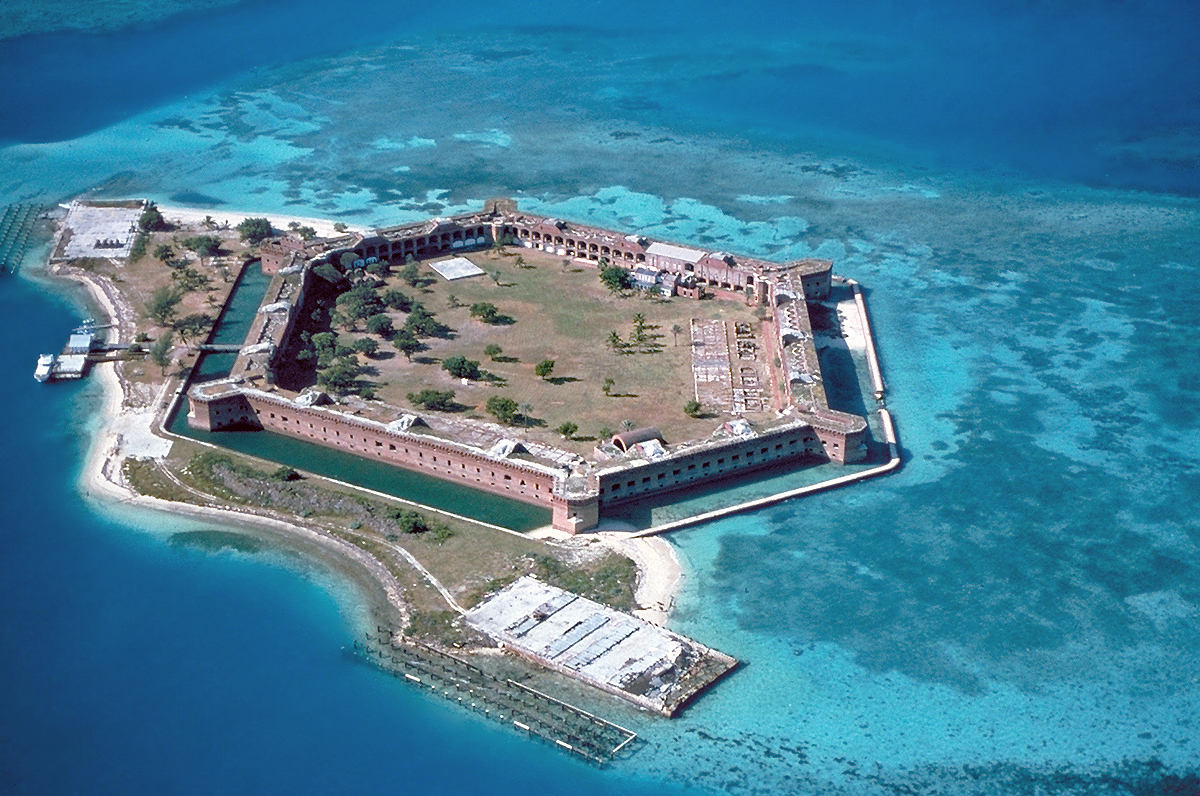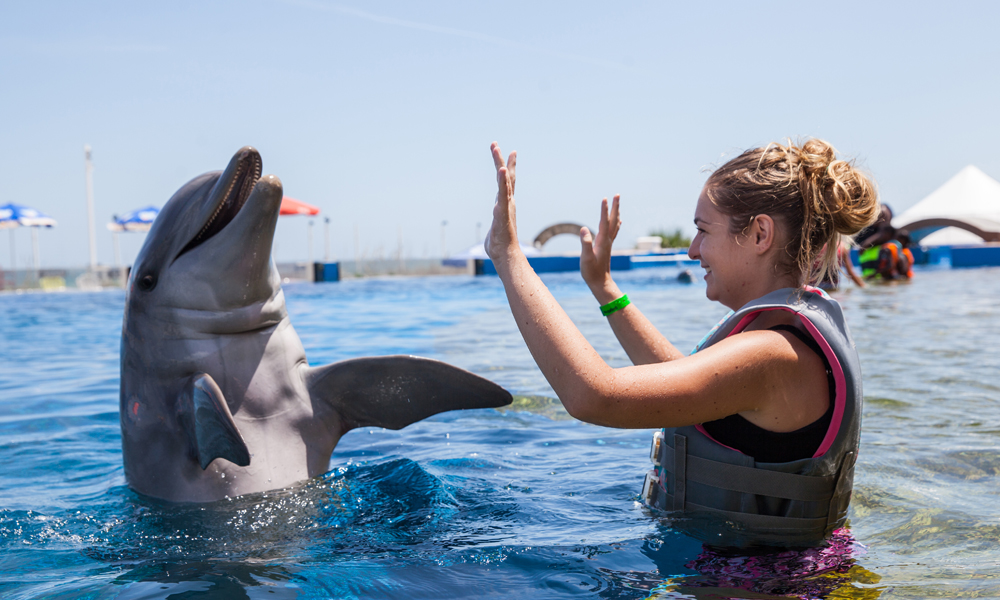1. Everglades National Park, in Southern Florida, on U.S. Route 41. "Largest remaining subtropical wilderness in the United States; open Everglades prairies, mangrove forests; abundant wildlife including rare and colorful birds."
Around 1,000,000,000 annual visitors. I have driven on the Tamiami Trail (U.S. 41) which goes along the edge of the park and we even stopped at a couple of roadside areas to take in the scene, so compared to most of these places I have kind of been there, but not really. It's pretty famous, I don't think I need to say too much about it.
2. Fort Matanzas National Monument, 10 miles south of St. Augustine, on U.S. Route 1. "Spanish fort built in 1737 to protect back door to St. Augustine. Near this site, Menendez massacred two parties of French Huguenots in 1565, thus determining that Florida should remain Spanish rather than French territory."
This is another place I intended to visit once but was unsuccessful in my efforts. I did drive past it on the highway at least. I made the mistake (I think I was still in my 30s at the time, and overambitious) of trying to pack in too much in one day. I thought we could drop in to St Augustine for a couple of hours first and see that. My 1950s and 60s travel books, which before I got a smart phone I used to consult a lot, had given me an idea of St Augustine as a sleepy, old Florida kind of place where I would be able to pull up my car on the main strip in the town and walk around pretty much on my own taking in the sites for a few hours. It was in fact overrun with traffic and tourists. The pictures we got from the day still look nice but there was no personal space to be found anywhere. After this nobody besides me was in the mood to visit the 18th century fort (1742 according the official web site) where the Huguenots had met their unfortunate fate so we ploughed on through to grandma's condo.
Pedro Menendez de Aviles: 1st governor of Florida. Appears to have been a capable military commander, definitely a conquistador type. There are some substantial monuments dedicated to him back in Spain.
3. Fort Jefferson National Monument, at Dry Tortugas, 60 miles west of Key West, on U.S. Route 1 (Key West, I presume). "Largest all-masonry fortification in western world; built in 1846 for control of Florida Straits. Federal military prison during and after the Civil War. Outstanding bird refuge; extraordinary marine life."
This looks like it would be a lovely spot to visit, but if you have a regular income it looks like it is quite expensive to get there. The ferry is almost $200 a person, and if you want to take the seaplane it'll cost you $634 for a full day excursion (the half day outing is only $341, but I don't like to be rushed). You can camp on the island(!), but you would have to bring everything with you on the ferry, food, ice, tent, drinking water. I think it would be worth doing once if you had the time and money. I can't find any more inexpensive way of getting there, unless you are able to go by private boat.
4. Mountain Lake Sanctuary, in central Florida, 12 miles east of Winter Haven, on U.S. Route 60. "Established by Edward Bok as a sanctuary for birds; overlooks some thirty lakes; on Iron Mountain, the highest point in Florida*. More than a hundred varieties of birds; beautiful plants, shrubs, and trees. Contains the Singing Tower, where Edward Bok is buried. High up in the tower is a magnificent set of 71 bells."
This is another site that I have almost been to. One year--a while ago now--when we were on our winter vacation in Sarasota I tried to squeeze in a visit on the way home. As often happens in such instances, we got off to a later start than I had planned, then hit terrible traffic getting out of Sarasota and up towards central Florida where the sanctuary is, though the sanctuary itself is in a less crowded area away from the highways that still maintains something of the old Florida look that I find in my guidebooks from the 50s and 60s. We pulled up at the gate of the place 5 minutes before they closed, so we didn't go in, though at least I was able to espy the top of the tower in the distance. At the time of course we planned to come back, but we have not to this point. It is relatively inexpensive ($15 for adults, $5 for children), and it looks like it is kind of grand and beautiful, Florida vegetation stretching over the flat land in all directions, a kind of vista we don't see the like of in the north. Edward Bok is not too famous anymore, but I have read his autobiography, which I enjoyed, so the place holds an interest for me.
*According to Wikipedia, Iron Mountain is only tied for the 13th highest point in Florida, though at 295 feet, it is just 60 feet lower than the highest point (Britton Hill, in the far northwest panhandle, near Alabama).
After a blissful day visiting the Sanctuary, Central Florida nightlife awaits to slap you back to reality.
5. Highlands Hammock State Park, in south central Florida, 6 miles west of Sebring, on U.S. Route 27. "One of the most remarkable scenic spots in the state, it adjoins the huge Florida Botanical Garden and Arboretum. A wilderness of dense jungle and swamps, it abounds with wild animals and birds."
This is another place that I have contemplated going to over the years, but as with the Bok Tower, it's about an hour and 40 minutes from where we stay in Sarasota when go down there, and there hasn't been enough enthusiasm from the crowd to commit to taking one of our precious Florida days to make it over there. But as people get older...maybe one of these years. This is one of four original Florida state parks, and appears to offer a pretty comprehensive Florida nature experience--cypresses, palmettoes, alligators, ibises, etc. The entry fee per vehicle is $6--$4 if you drive in by yourself, making this a serious bargain for a quality day out in this part of the world. You can camp there as well, and even the campground gets mostly very positive online reviews, which is rare.
The botanical garden and arboretum mentioned in the article was part of the original plan for the park, but this seems to have been abandoned as far back as 1939, and the area set aside for the garden incorporated into the main body of the park. This does not seem to exist as a separately cultivated area today.
6. Silver Springs, in central Florida, 6 miles east of Ocala, on U.S. Route 27. "One of the largest springs in the world. Strange underwater plants, turtles, and fish may be seen from special boats."
I have often seen advertisements for this place, either on road signs or tourist brochures, promoting it as a genuine, even classic "old-time Florida" attraction, especially famous for its glass bottom boat tours, which date back to the 1870s. I remember looking into this some years back and thinking it was fairly expensive, $30 or $40 a person, though obviously much cheaper than the likes of Disney World would be. In 2013 the state of Florida took it over and turned it into a state park, which has made it much cheaper to get onto the grounds at least, though the boat tours are a separate fee, the pricing system for which seems a little convoluted, in the sense that it is not easily obvious to me how much a family outing say would cost. The park was "whites only" until 1967, as were presumably most of the IWE recommended sites in the southern states, as these seem to have been written around 1960. The writers never remark or otherwise comment on this in these travel sections.
Originally opened in 1938, Marineland has a rather complicated history. During its heyday in the 1950s, the complex included three motels, a restaurant, and a bar called the Moby Dick Lounge which was frequented by a number of literary celebrities, including Hemingway, Marjorie Kinnan Rawlings, John Dos Passos, and Leo Tolstoy's grandson. The Wikipedia article on the site also notes that the park was famous for its employee Christmas parties, "a tradition starting in the early days lasting into the 1990s". (Hey, I could have gone to one of those!)* Starting around 1987, the attraction began a period of sustained decline. Layoffs came in the late 90s, and a series of hurricanes between 1999 & 2004, combined with ongoing deterioration of the facilities and decline in attendance already in progress, caused the closing of the park in 2004, with a declaration of bankruptcy and the selling off of such assets as remained. Remarkably, some serious scientific entities, such as the Dolphin Conservation Center Center and the Georgia Aquarium, took an interest in rehabilitating the site, and renovations were undertaken to bring the marine facilities especially up to date. The park reopened in 2006, the Dolphin show and other pure entertainments of old having been reinvented as more of a hands on learning and conservation experience. After reading through all of this history I feel like I really do need to drop in on this place if I ever get the opportunity (though alas, the bar, restaurant and motels are gone. It sounds like the original gift shop building at least has been preserved).
*I did a quick search looking for more information about these legendary Christmas parties, but I didn't find anything.












No comments:
Post a Comment